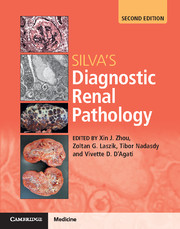Book contents
- Silva’s Diagnostic Renal Pathology
- Silva’s Diagnostic Renal Pathology
- Copyright page
- Dedication
- Contents
- Contributors
- Foreword
- Preface to the First Edition
- Preface to the Second Edition
- Abbreviations
- Chapter 1 Renal Development and Anatomy
- Chapter 2 Renal Biopsy: The Nephrologist’s Viewpoint
- Chapter 3 Algorithmic Approach to the Interpretation of Renal Biopsy
- Chapter 4 Glomerular Diseases Associated with Nephrotic Syndrome and Proteinuria
- Chapter 5 Glomerular Diseases Associated Primarily with Asymptomatic or Gross Hematuria
- Chapter 6 Infection-related Glomerulonephritis, Membranoproliferative Pattern of Glomerulonephritis, and Nephritic Syndrome
- Chapter 7 Glomerular Diseases Associated with Crescentic Glomerulonephritis (Rapidly Progressive Glomerulonephritis)
- Chapter 8 Systemic Lupus Erythematosus and Other Autoimmune Diseases (Mixed Connective Tissue Disease, Rheumatoid Arthritis, and Sjogren’s Syndrome)
- Chapter 9 Metabolic Diseases of the Kidney
- Chapter 10 Thrombotic Microangiopathies
- Chapter 11 Renal Diseases Associated with Hematopoietic Disorders or Organized Deposits
- Chapter 12 Tubulointerstitial Diseases
- Chapter 13 Hypertension and Vascular Diseases of the Kidney
- Chapter 14 Cystic and Developmental Diseases of the Kidney
- Chapter 15 The Aging Kidney and End-stage Renal Disease
- Chapter 16 Pathology of Renal Transplantation
- Chapter 17 Digital Renal Pathology
- Index
- References
Chapter 16 - Pathology of Renal Transplantation
Published online by Cambridge University Press: 01 March 2017
- Silva’s Diagnostic Renal Pathology
- Silva’s Diagnostic Renal Pathology
- Copyright page
- Dedication
- Contents
- Contributors
- Foreword
- Preface to the First Edition
- Preface to the Second Edition
- Abbreviations
- Chapter 1 Renal Development and Anatomy
- Chapter 2 Renal Biopsy: The Nephrologist’s Viewpoint
- Chapter 3 Algorithmic Approach to the Interpretation of Renal Biopsy
- Chapter 4 Glomerular Diseases Associated with Nephrotic Syndrome and Proteinuria
- Chapter 5 Glomerular Diseases Associated Primarily with Asymptomatic or Gross Hematuria
- Chapter 6 Infection-related Glomerulonephritis, Membranoproliferative Pattern of Glomerulonephritis, and Nephritic Syndrome
- Chapter 7 Glomerular Diseases Associated with Crescentic Glomerulonephritis (Rapidly Progressive Glomerulonephritis)
- Chapter 8 Systemic Lupus Erythematosus and Other Autoimmune Diseases (Mixed Connective Tissue Disease, Rheumatoid Arthritis, and Sjogren’s Syndrome)
- Chapter 9 Metabolic Diseases of the Kidney
- Chapter 10 Thrombotic Microangiopathies
- Chapter 11 Renal Diseases Associated with Hematopoietic Disorders or Organized Deposits
- Chapter 12 Tubulointerstitial Diseases
- Chapter 13 Hypertension and Vascular Diseases of the Kidney
- Chapter 14 Cystic and Developmental Diseases of the Kidney
- Chapter 15 The Aging Kidney and End-stage Renal Disease
- Chapter 16 Pathology of Renal Transplantation
- Chapter 17 Digital Renal Pathology
- Index
- References
- Type
- Chapter
- Information
- Silva's Diagnostic Renal Pathology , pp. 583 - 628Publisher: Cambridge University PressPrint publication year: 2017



